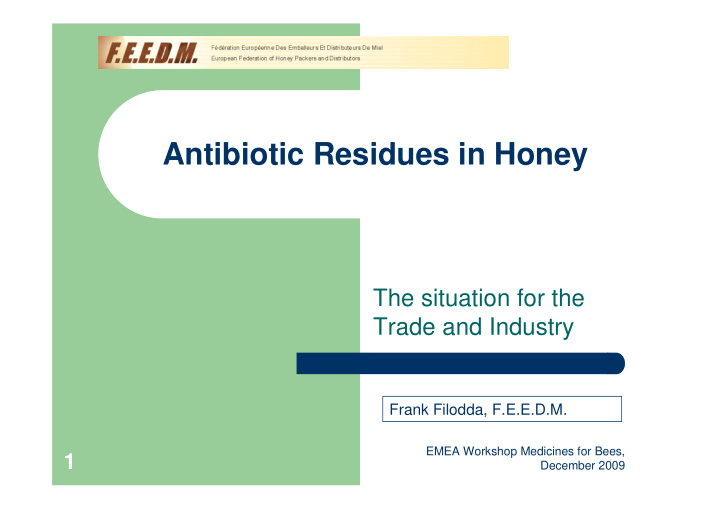



Antibiotic Residues in Honey The situation for the Trade and Industry Frank Filodda, F.E.E.D.M. EMEA Workshop Medicines for Bees, 1 December 2009
Main concern of Trade and Industry � Antibiotic Residues are found in honey � Antibiotics in beekeeping are not only used in Third countries � Antibiotics are also used in EU member states ! 2 EMEA Workshop December 2009
Reasons for use of Antibiotics � Beekeepers fear loosing beehives � Main indication for use of antibiotics are American and European Foulbrood 3 EMEA Workshop December 2009
Most often Antibiotics used in beekeeping � Streptomycine � Sulfonamides � Tetra- and Oxytetracyclines � Tylosin � Macrolides 4 EMEA Workshop December 2009
Availability � Third Countries (some) – Some products are authorized – MRLs are established for some substances – Use of some antibiotics is legal � EU – No products authorized – No MRLs established – Use of antibiotics is forbidden 5 EMEA Workshop December 2009
Problems � Official “zero tolerance” policy of the EU � Number of authorized medicine remains limited � Beekeepers use no adequate medicine � Necessity to fix control methods � Necessity to fix detection limits � Different and changing analysis methods � Sampling methods not established . . . � NO harmonised system in the EU member states 6 EMEA Workshop December 2009
Legalization Process (in general) � Application to EMEA – Safety dossier – Residue data aiming to establish ADI – Toxicity studies 7 EMEA Workshop December 2009
But Assessment in Honey is complex � Once treatment is done, residues remain in honey � No withdrawal period from treatment to harvest of honey � Monitoring or exposure data can be taken into consideration 8 EMEA Workshop December 2009
MRLs for Honey � Main antibiotic substances found in honey have MRLs for other species � ADI for those substances is known � = extension of the MRLs for bees/honey required 9 EMEA Workshop December 2009
Marketing authorization for products � Bees/honey is considered as minor species � Certain requirements are eased for small to medium sized companies � Market is unknown, maybe limited � Limited interest of pharmaceutical companies to place products 10 EMEA Workshop December 2009
Concerns � Antibiotics may not be helpful � Other options could be considered � Resistance development may limit the use of antibiotics for animals and humans (this applies to all species) � Residues in honey spoil the image of the product 11 EMEA Workshop December 2009
FEEDMs’ trial on Oxytetracycline � Pfizer in cooperation of BHIPA applied for Oxytetracyclin in 2005 � CVMP recommends MRL of 25µg/kg the19th April 2006 for Anex I of 2377/90 � EU Commission complains that ADI of Oxytetracycline is already exceeded and asked for revision � CVMP reconfirms 25µg/kg on 19th Feb 2007 � Since than involved DGs could not agree on whether including Oxytetracyclin for honey in Anex I or III of 2377/90 � _____________________________________________ � No harm for human consumers but still “zero tolerance” 12 EMEA Workshop December 2009
New attempt � COPA/COGECA, FEEDM, IHC � Parties involved ask the Commission for MRLs – Flourquinolones 0,005 ppm – Macrolides 0,020 ppm – Streptomycins 0,010 ppm – Sulphonamides 0,010 ppm – Tetracyclines 0,010 ppm Low limits to be fixed for legal security (Sep 2009) 13 EMEA Workshop December 2009
The Commissions’ reply � DG Enterprise Letter submitted to DG Sanco for RPAs – Request on MRLs may be submitted to EMEA – � Article 9(1)b of EC No 470/2009 and Art. 11 of 2001/82 � DG Sanco Commission may establish RPAs – Alternative are MRLs, – � according to 470/2009, arts 5 (EMEA) and 6(3) DG Enterprise is responsible – � EMEA Only a member state or the Commission may ask for MRL – � according to Art 9 of EC 470/2009 DG Sanco is responsible for RPAs – 14 EMEA Workshop December 2009
Which way has to be taken? 15 EMEA Workshop December 2009
Recommend
More recommend